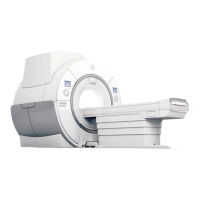8.2 Equipment Heat Output Specifications
This section details the heat output for specific components. These heat outputs define the
maximum condition. Actual heat output and room temperature may vary due to environmental
factors, room insulation, actual usage, and any non-GE Healthcare equipment used in the MR
suite. Also, due to large variations in heat loads, the HVAC system may require unloaders, hot
gas bypass, and reheat to maintain humidity levels.
Table 2-8: System Heat Output for Air Cooling
Component Magnet Room
BTU/hr (W)
Equipment Room
BTU/hr (W)
Control Room
BTU/hr (W)
Maximum Average
Idle
Maximum Average
Idle
Maxi‐
mum
Aver‐
age Idle
Magnet (MAG) and Patient
Transport Table (PT)
8,189
(2,400)
4,095
(1,200)
1,915
(561)
Main Disconnect Panel (MDP,
optional)
901 (264) 450 (132)
450
(132)
Integrated System Cabinet
(ISC)
24,232
(7,100)
7,270*
(2,130)
955*
(280)
Heat Exchanger Cabinet (ICC) 3,412
(1,000)
1,706*
(500)
0* (0)
Cryocooler Compressor (CRY)
1,706 (500)
1,706
(500)
1,706
(500)
Magnet Monitor (MON) 205 (60) 205 (60) 205 (60)
Operator Workspace equip‐
ment (OW)
4,947 (1,450)
NOTE: For ISC and ICC, Average value is calculated using Standby mode and Idle value is
calculated using Night Mode (Power Off Mode).
Table 2-9: System Options Heat Output for Air Cooling
Component
Magnet
Room
BTU/hr
(W)
Equipment
Room
BTU/hr (W)
Control
Room
BTU/hr (W)
MR Elastography
480 (141)
SIGNA Voyager Pre-Installation
Direction 5680008–1EN, Revision 2
Chapter 2 General System Level 43

